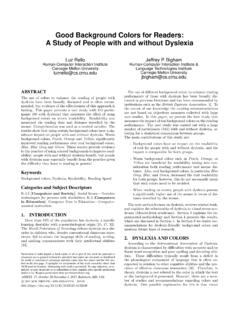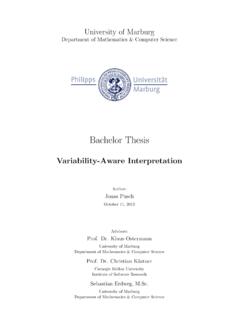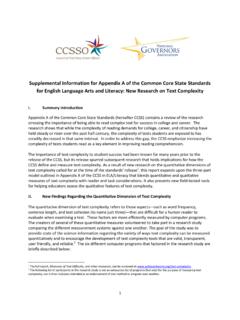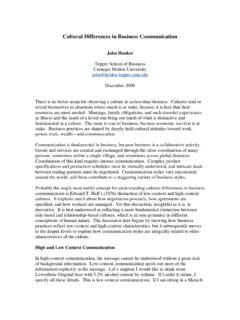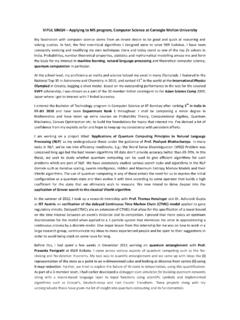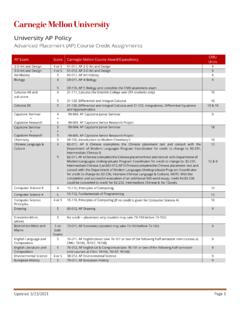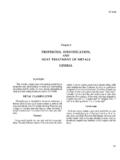Transcription of Simple Demographics Often Identify People Uniquely
1 L. Sweeney, Simple Demographics Often Identify People Uniquely . carnegie mellon university , Data Privacy Working Paper 3. Pittsburgh 2000. Sweeney Page 1 Simple Demographics Often Identify People Uniquely Latanya Sweeney carnegie mellon university This work was funded in part by H. John Heinz III School of Public Policy and Management at carnegie mellon university and by a grant from the Bureau of Census. Copyright 2000 by Latanya Sweeney. All rights reserved. L. Sweeney, Simple Demographics Often Identify People Uniquely . carnegie mellon university , Data Privacy Working Paper 3. Pittsburgh 2000. Sweeney Page 2 1.
2 Abstract In this document, I report on experiments I conducted using 1990 Census summary data to determine how many individuals within geographically situated populations had combinations of demographic values that occurred infrequently. It was found that combinations of few characteristics Often combine in populations to Uniquely or nearly Uniquely Identify some individuals. Clearly, data released containing such information about these individuals should not be considered anonymous. Yet, health and other person-specific data are publicly available in this form. Here are some surprising results using only three fields of information, even though typical data releases contain many more fields. It was found that 87% (216 million of 248 million) of the population in the United States had reported characteristics that likely made them unique based only on {5-digit ZIP, gender, date of birth}. About half of the population (132 million of 248 million or 53%) are likely to be Uniquely identified by only {place, gender, date of birth}, where place is basically the city, town, or municipality in which the person resides.
3 And even at the county level, {county, gender, date of birth} are likely to Uniquely Identify 18% of the population. In general, few characteristics are needed to Uniquely Identify a person. 2. Introduction Data holders Often collect person-specific data and then release derivatives of collected data on a public or semi-public basis after removing all explicit identifiers, such as name, address and phone number. Evidence is provided in this document that this practice of de-identifying data and of ad hoc generalization are not sufficient to render data anonymous because combinations of attributes Often combine Uniquely to re- Identify individuals. Linking to re- Identify de-identified data In this subsection, I will demonstrate how linking can be used to re- Identify de-identified data. The National Association of Health Data Organizations (NAHDO) reported that 44 states have legislative mandates to collect hospital level data and that 17 states have started collecting ambulatory care data from hospitals, physicians offices, clinics, and so forth [1].
4 These data collections Often include the patient s ZIP code, birth date, gender, and ethnicity but no explicit identifiers like name or address. The leftmost circle in Figure 1 contains some of the data elements collected and shared. For twenty dollars I purchased the voter registration list for Cambridge Massachusetts and received the information on two diskettes [2]. The rightmost circle in Figure 1 shows that these data included the name, address, ZIP code, birth date, and gender of each voter. This information can be linked using ZIP, birth date and gender to the medical information, thereby linking diagnosis, procedures, and medications to particularly named individuals. The question that remains of course is how unique would such linking be. In general I can say that the greater the number and detail of attributes reported about an entity, the more likely that those attributes combine Uniquely to Identify the entity.
5 For example, in the voter list, there were 2 possible values for gender and 5 possible five-digit ZIP codes; birth dates were within a range of 365 days for 100 years. This gives 365,000 unique values, but there were only 54,805 voters. L. Sweeney, Simple Demographics Often Identify People Uniquely . carnegie mellon university , Data Privacy Working Paper 3. Pittsburgh 2000. Sweeney Page 3 EthnicityVisit dateDiagnosisProcedureMedicationTotal chargeZIPB irthdateSexNameAddressDateregisteredPart yaffiliationDate lastvotedMedical DataVoter List Figure 1 Linking to re- Identify data Publicly and semi-publicly available health data As mentioned in the previous subsection, most states (44 of 50 or 88%) collect hospital discharge data [3].
6 Many of these states have subsequently distributed copies of these data to researchers, sold copies to industry and made versions publicly available. While there are many possible sources of patient-specific data, these represent a class of data collections that are Often publicly and semi-publicly available. # Field description Size1 HOSPITAL ID NUMBER 122 PATIENT DATE OF BIRTH (MMDDYYYY) 83 SEX 14 ADMIT DATE (MMDYYYY) 85 DISCHARGE DATE (MMDDYYYY) 86 ADMIT SOURCE 17 ADMIT TYPE 18 LENGTH OF STAY (DAYS) 49 PATIENT STATUS 210 PRINCIPAL DIAGNOSIS CODE 611 SECONDARY DIAGNOSIS CODE - 1 612 SECONDARY DIAGNOSIS CODE - 2 613 SECONDARY DIAGNOSIS CODE - 3 614 SECONDARY DIAGNOSIS CODE - 4 615 SECONDARY DIAGNOSIS CODE - 5 616 SECONDARY DIAGNOSIS CODE - 6 617 SECONDARY DIAGNOSIS CODE - 7 618 SECONDARY DIAGNOSIS CODE - 8 619 PRINCIPAL PROCEDURE CODE 720 SECONDARY PROCEDURE CODE - 1 721 SECONDARY PROCEDURE CODE - 2 722 SECONDARY PROCEDURE CODE - 3 723 SECONDARY PROCEDURE CODE - 4 724 SECONDARY PROCEDURE CODE - 5 725 DRG CODE 3# Field description Size26 MDC CODE 227 TOTAL CHARGES 928 ROOM AND BOARD CHARGES 929 ANCILLARY CHARGES 930 ANESTHESIOLOGY CHARGES 931 PHARMACY CHARGES 932 RADIOLOGY CHARGES 933 CLINICAL LAB CHARGES 934 LABOR-DELIVERY CHARGES 935 OPERATING ROOM CHARGES 936 ONCOLOGY CHARGES 937 OTHER CHARGES 938 NEWBORN INDICATOR 139 PAYER ID 1 940 TYPE CODE 1 141 PAYER ID 2 942 TYPE CODE 2 143 PAYER ID 3 944 TYPE CODE 3 145 PATIENT ZIP CODE 546 Patient Origin COUNTY 347 Patient
7 Origin PLANNING AREA 348 Patient Origin HSA 249 PATIENT CONTROL NUMBER50 HOSPITAL HSA 2 Figure 2 IHCCCC Research Health Data The Illinois Health Care Cost Containment Council (IHCCCC) is the organization in the State of Illinois that collects and disseminates health care cost data on hospital visits in Illinois. IHCCCC reports more than 97% compliance by Illinois hospitals in providing the information L. Sweeney, Simple Demographics Often Identify People Uniquely . carnegie mellon university , Data Privacy Working Paper 3. Pittsburgh 2000. Sweeney Page 4 [4]. Figure 2 contains a sample of the kinds of fields of information that are not only collected, but also disseminated.
8 Of the states mentioned in the NAHDO report, 22 of these states contribute to a national database called the State Inpatient Database (SID) sponsored by the Agency for Healthcare Research and Quality (AHRQ). A copy of each patient s hospital visit in these states is sent to AHRQ for inclusion in SID. Some of the fields provided in SID are listed in Figure 3 along with the compliance of the 13 states that contributed to SID s 1997 data [5]. FieldComments#states%statesPatient Ageyears13100%Patient Date of birth month, year538%Patient Gender 13100%Patient Racial background 1185%Patient ZIP 5-digit969%Patient IDencrypted (or scrambled)323%Admission datemonth, year862%Admission day of week1292%Admission sourceemergency, court/law, etc13100%Birth weight for newborns538%Discharge datemonth, year754%Length of stay13100%Discharge statusroutine, death, nursing home, etc13100%Diagnosis Codes ICD9, from 10 to3013100%Procedure Codesfrom 6 to 2113100%Hospital ID AHA#1292%Hospital county1292%Primary payerMedicare, insurance, self-pay, etc13100%Chargesfrom 1 to 63 categories1185% Figure 3 Some data elements for AHRQ s State Inpatient Database (13 participating states)
9 State Month and Year of Birth date Age Arizona Yes Yes California Yes Colorado Yes Florida Yes Iowa Yes Yes Massachusetts Yes Maryland Yes New Jersey Yes New York Yes Yes Oregon Yes Yes South Carolina Yes Washington Yes Wisconsin Yes Yes Figure 4 Age information provided by states to SID Figure 4 lists the states reported in Figure 3 that provide the month and year of birth and the age for each patient.
10 L. Sweeney, Simple Demographics Often Identify People Uniquely . carnegie mellon university , Data Privacy Working Paper 3. Pittsburgh 2000. Sweeney Page 5 The remainder of this document provides experimental results from summary data that show how Demographics Often combine to make individuals unique or almost unique in data like these. A single attribute The frequency with which a single characteristic occurs in a population can help Identify individuals based on unusual or outlying information. Consider a frequency distribution of birth years found in the list of registered voters. It is not surprising to see fewer People present with earlier birth years.

